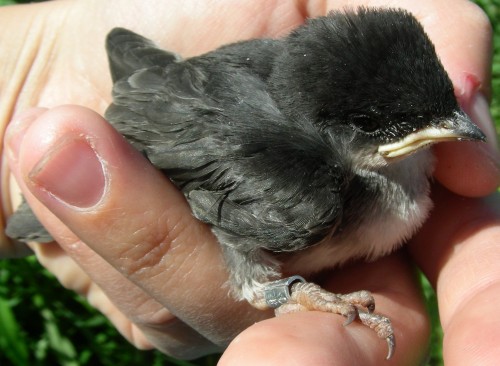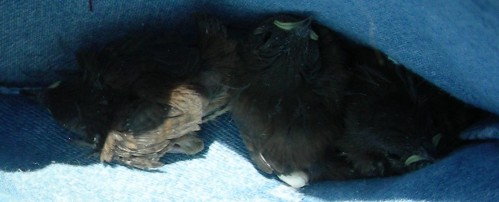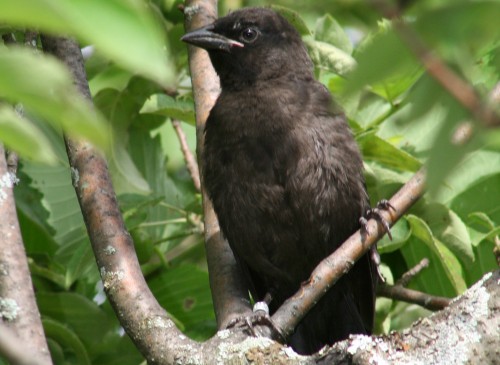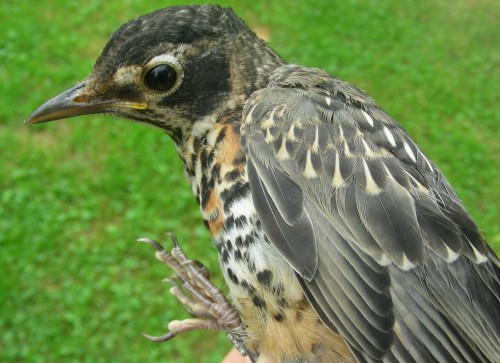June 6 – 30, 2007
|
|
| THIS MONTH | THIS SUMMER | 2007 TOTAL | SITE TOTAL | |
|---|---|---|---|---|
| # birds (and species) banded | 30 (3) | 30 (3) | 775 (65) | 10093 (98) |
| # birds (and species) repeat | — | — | 115 (21) | 1664 (53) |
| # birds (and species) return | — | — | 85 (21) | 285 (28) |
| # species observed | 60 | 60 | 135 | 186 |
| # net hours | 0 | 0 | 2497 | 16519.8 |
| # birds banded / 100 net hours | n/a | n/a | 30.9 | 61.0 |
Note: table does not include nocturnal banding (owls).
Bander-in-charge: Marie-Anne Hudson Assistants: Dave Bird, Shawn Craik, Gay Gruner, Chris Murphy, Rodger Titman
Notes: June has come and gone at an incredible rate – leaving us wondering where the summer’s gone! Our first census of the summer season was conducted on the 11th of June, and they’ve been going about once or twice a week since then thanks to our loyal censusers (please see above).The average number of species seen during each visit ranged between 29 and 39, however the total number of species observed during the month of June was a respectable 60, an increase from the 52 observed during this period last year.
Much like last year at this time, most of the birds that have remained at MBO have settled down to breed, becoming quite quiet. Most noticeably, the Common Yellowthroats have almost completely ceased singing, opting instead to skulk around the bushes and ‘cheack’ at you as you walk by. The Rose-breasted Grosbeaks and Warbling Vireos, once so vocal it was hard to hear anything else, have fallen completely silent. Our birds have not wasted any time: we’ve had young Wood Ducks, Canada Geese, House Sparrows, Eastern Kingbirds (a first as far as we know for MBO), American Robins, Red-winged Blackbirds, Tree Swallows, House Wrens, and… Great-crested Flycatchers! Though these young are still in the egg (in one of the nest boxes we’re keeping a close eye on), we still count them as young-to-be.
|
|
The list of birds banded this month is comprised almost entirely of almost-fledged juveniles, with the exception of one second-year female Tree Swallow who was quickly banded after she wouldn’t budge off her nest of newly hatched young.
| # individuals banded | mean # individuals observed daily |
|---|---|
| 1. Tree Swallow (20) | Red-winged Blackbird (42.3) [1] |
| House Wren (6) | American Goldfinch (14.3) [4] |
| Eastern Kingbird (4) | Tree Swallow (14.3) [3] |
| American Crow (14) [2] | |
| Yellow Warbler (9)[6] | |
| Cedar Waxwing (7.7)[5] | |
| Song Sparrow (7) [8] | |
| Baltimore Oriole (6.5) [-] | |
| Common Yellowthroat (5.3) [7] | |
| American Robin (4.5) [-] |
The ten species most frequently observed this month were roughly the same as the last week of the spring season, though their order of abundance changed somewhat, and a couple of additions were made. Red-winged Blackbirds continue to dominate, while American Goldfinch and American Crow have traded spots, as have Yellow Warbler and Cedar Waxwing. Overall, this list represents the most common breeding species at MBO. Seven of last June’s top 8 species are in this year’s top 10, with the lone exception being Ring-billed Gull; Red-winged Blackbird and American Goldfinch also held the top two places in 2006.
The vegetation has really gone wild, with some of the grasses in the meadow now taller than most of us (but probably not Marcel). This makes it all the more difficult to locate dropped items, such as the small mirrors we carry to quickly check the contents of the nest boxes! We hope to continue censusing throughout July, and will begin to gear up for the upcoming fall season soon. There will be much vegetation management to do, so we are on the lookout for hard-working volunteers to help us tame those thickets! Along those lines, we would like to extend a HUGE thank you to Maria, Barbara and Peter Frei (no relation) for spending several hot summer days working on MBO’s newest installation: the composting toilet! We hope to have it up and running in time for the fall season, and cannot thank them enough for their wonderful craftsmanship and all-around hard work. Sincere thanks also to Sun-Mar, who provided the toilet at a considerable discount.
|
|
July 1 – 31, 2007
|
|
| THIS MONTH | THIS SUMMER | 2007 TOTAL | SITE TOTAL | |
|---|---|---|---|---|
| # birds (and species) banded | 9 (4) | 39 (6) | 784 (65) | 10102 (98) |
| # birds (and species) repeat | — | — | 115 (21) | 1664 (53) |
| # birds (and species) return | — | — | 85 (21) | 285 (28) |
| # species observed | 49 | 64 | 135 | 186 |
| # net hours | 2. 8 | 2. 8 | 2499.75 | 16522.5 |
| # birds banded / 100 net hours | 178.6 | 178.6* | 31.2 | 61.1 |
Note: table does not include nocturnal banding (owls) * Almost all banded birds were caught in nest-boxes or taken from nests, so the number of birds banded per 100 net hours applies only to the 5 birds caught in the mist-nets.
Banders-in-charge: Marie-Anne Hudson, Barbara Frei Assistants: Gay Gruner, Penny Letchuk, Barbara Macduff, Sarah Marteinson, Chris Murphy, Greg Rand, Helena Scheffer
Notes: July, like June, whizzed by at a phenomenal rate! Our last census of the summer season was conducted on the 29th of July, yielding dozens of young birds from this year. Young ones began appearing in June, and we’ve had records of fledgling Downy Woodpecker, Eastern Kingbird, Song Sparrow, Tree Swallow, Great Crested Flycatcher (though they fledged out of box 33 before we could band them), House Wren, Warbling Vireo, Black-capped Chickadee, American Robin, Red-winged Blackbird, and Yellow Warbler. The average number of species seen during each visit ranged between 25 and 30, and the total number of species observed during the month of July was 49, a substantial decrease from June and the 61 species from last July, but understandable due to fewer observation hours (and most of those were spent wrestling with vegetation and not paying terribly close attention to the birds flitting around).
The list of birds banded this month at MBO is a short one. The four Tree Swallows banded were the last batch out of a nest box. The other entries are from a modest banding effort put on to introduce banding to a group of 12 kids visiting from the Redpath Museum. This list is a little deceptive, however, because at least 50 birds were banded during the summer months. Why don’t they show up in our table? Because the banding was done at Le Nichoir, a bird rehabilitation centre in Hudson. We were asked to band young birds that had been raised at Le Nichoir by its hard-working staff, so that they might be able to keep track of them once released, either by spotting them hanging around in groups by the feeders, acclimating to their new environment, or by band number returns from birds that were found dead or killed, or ideally of course recaptured alive and well much later at MBO or other observatories. We were extremely saddened to hear of the demise of 3 released young ones – all by the paw of the same neighborhood cat. We would like to use this example to implore cat owners to keep their cats indoors or on leashes, so that other young birds such as the young Downy Woodpeckers, Northern Flickers, Great Crested Flycatchers, American Robins, Common Grackles, and House Finches that we banded this month have a chance to survive, migrate, and come back to breed themselves.
| # individuals banded | mean # individuals observed daily |
|---|---|
| 1. Tree Swallow (4) | Red-winged Blackbird (22) [1] |
| Song Sparrow (3) | Song Sparrow (14) [7] |
| Cedar Waxwing (1) | American Goldfinch (11) [2] |
| Indigo Bunting (1) | Black-capped Chickadee (8) [-] |
| American Crow (7) [4] | |
| European Starling (7) [-] | |
| Tree Swallow (6) [3] | |
| Yellow Warbler (5) [5] | |
| Cedar Waxwing (4) [6] | |
| American Robin (4) [10] |
The ten species most frequently observed this month were roughly the same as last month’s, though again their order of abundance changed somewhat, and a couple of additions were made. Red-winged Blackbirds continue to dominate and are beginning to flock. The number of young Song Sparrows and Black-capped Chickadees is increasing quite substantially, while American Goldfinch and American Crow have slipped a little. Seven of last July’s top 10 species are in this year’s top 10. In fact, the top three in both years are the exact same species!
Another month, another huge thank you to our hard-working volunteers for 1) taming the vegetation around the net lanes, J-trap, and census route; 2) cleaning out the banding station; and 3) building the most beautiful composting toilet cabin we’ve ever seen. A coat of paint and a few pipes here and there and it will be good to go! With the fall banding season just a few days away, it’s just in time. We’re very excited about the upcoming season, and hope to see you all out there soon.
|
|
 Tree Swallows again are leading the list of birds banded at MBO during the breeding season, with several boxes full of nestlings. We have already had foreign recoveries of MBO-raised Tree Swallows, and hope that by continuing to band the locally produced young, we will learn more about their dispersal patterns. (Photo by Marie-Anne Hudson)
Tree Swallows again are leading the list of birds banded at MBO during the breeding season, with several boxes full of nestlings. We have already had foreign recoveries of MBO-raised Tree Swallows, and hope that by continuing to band the locally produced young, we will learn more about their dispersal patterns. (Photo by Marie-Anne Hudson) These young Eastern Kingbirds settled back into their nest quite nicely after being banded. Not shown in the photo, momma Kingbird was hovering nearby the entire time, keeping a watchful eye on her young. (Photo by Marie-Anne Hudson)
These young Eastern Kingbirds settled back into their nest quite nicely after being banded. Not shown in the photo, momma Kingbird was hovering nearby the entire time, keeping a watchful eye on her young. (Photo by Marie-Anne Hudson) These little guys were the first juvenile House Wrens ever banded at MBO. (Photo by Marie-Anne Hudson)
These little guys were the first juvenile House Wrens ever banded at MBO. (Photo by Marie-Anne Hudson) By banding young birds before their release at Le Nichoir, like this young Common Grackle, we hope to learn how long they stay in the area after release, and to hopefully resight them for years to come. (Photo by Greg Rand)
By banding young birds before their release at Le Nichoir, like this young Common Grackle, we hope to learn how long they stay in the area after release, and to hopefully resight them for years to come. (Photo by Greg Rand) This cute little American Robin banded at Le Nichoir before its release is still sporting its baby spots and fleshy gape, sure signs that it’s a young one. (Photo by Marie-Anne Hudson)
This cute little American Robin banded at Le Nichoir before its release is still sporting its baby spots and fleshy gape, sure signs that it’s a young one. (Photo by Marie-Anne Hudson)